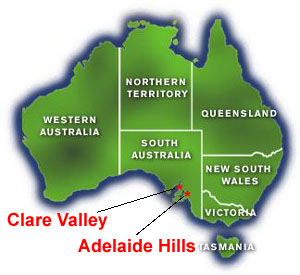|

© by Sheral Schowe
Since Australian wines hit the U.S. market, varietal wines have been characterized as having one particular "style." As we begin to import the wines from smaller wineries, we are discovering the uniqueness in styles that site-specific terroirs have to offer. Each grape varietals reflects these amazing differences, Sauvignon Blanc, Riesling, Pinot Noir, and Shiraz. Australian wines can no longer be relegated to any one specific style. Take three Sauvignon Blancs, for instance, from relatively small properties. Each come from exactly the same rootstock. Each are made in exactly the same way. The differences are attributed to the site of the vineyard. The differences come only from terroir. Pikes Sauvignon Blanc is raised in the Hill River region of the Clare Valley, which is the lowest in elevation. The soils are broken slate and shale in one of the largest contiguous quarries in Australia, possibly the world. The style is tropical, smooth, melony and slightly herbaceous. It is easy drinking and exceptionally food friendly. It is similar to many Sauvignon Blancs from California. (For more about Pikes, see their Website, http://www.winetitles.com.au/pikes/index.html. Shaw and Smith is like a Sancerre with a new world twist. It is grown in the Adelaide Hills in ancient, heavily leached soils, which are perfect for Sauvignon Blancs. It is fresh, crisp, and clean, with citrus flavors. If I were to choose a favorite of the three, it would be the Shaw and Smith. (Shaw and Smith does not appear to have a Website.) Knappstein Lenswood, also from the Adelaide Hills, is the most intense of the three Sauvignon Blancs. It has interesting aromas and flavors of gooseberry and dried herbs. It has a razor-sharp finish with lemon-peel acidity. Here's the Knappstein Lenswood Website: http://www.knappsteinlenswood.com.au/. The fun part of all of this tasting, in addition to the inherent pleasure, is in the discovery of the terroir in the wine. Now that I have, given you the real "dirt" on Australian Sauvignon Blancs, it's your turn to discover your favorite style. Aug. 8, 2000
|
